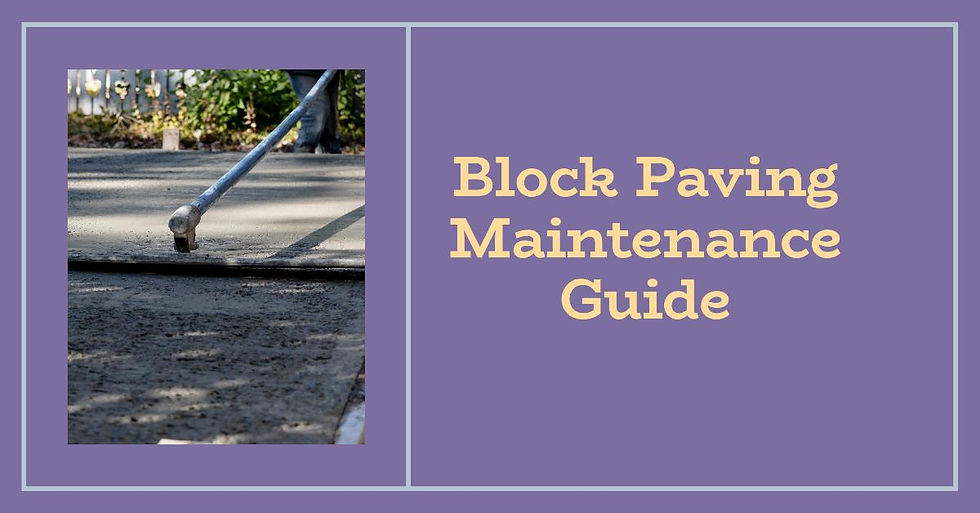How To Keep Block Paving Free of Weeds, Algae and Black Lichen Spots After Refurbishment
- Subhodip Unitel
- Jul 23, 2024
- 3 min read
Block paving is a popular choice for driveways, patios, and pathways due to its durability and aesthetic appeal. However, after refurbishment, it's essential to maintain it properly to ensure it remains in pristine condition. One of the common issues homeowners face with block paving is the growth of weeds, algae, and black lichen spots. In this comprehensive guide, we'll explore effective methods to keep your block paving looking its best, including tips on cleaning, maintaining, and protecting it from these unsightly problems.

Understanding the Challenges
Block paving can be susceptible to several issues if not properly maintained. Weeds can grow through the joints between the blocks, while algae and black lichen can develop on the surface, especially in shaded or damp areas. These problems not only detract from the appearance of your paving but can also lead to deterioration over time.
How to Clean and Renovate Block Paving
1. Initial Cleaning
Before tackling weeds, algae, and black lichen, it's crucial to perform a thorough cleaning of your block paving. Start by removing any loose debris and dirt using a broom or blower. Follow up with a pressure washer to clean the surface, ensuring you reach into the joints between the blocks. Be careful not to use too high a pressure, as this can damage the surface of your paving.
2. Removing Weeds
To keep your block paving free of weeds, you'll need to address both the existing weed growth and prevent future outbreaks. For existing weeds, use a weed killer suitable for block paving or a solution of vinegar and water. Apply it directly to the weeds and allow it to work before removing the dead plants. For long-term prevention, consider applying a weed suppressant membrane before refilling the joints with new sand.
How Can You Maintain Pavers & Keep Them Weed-Free?
1. Regular Maintenance
Maintaining your block paving involves regular upkeep to prevent issues before they become significant problems. Sweep the surface regularly to remove debris and dirt, which can provide a breeding ground for weeds and algae. Additionally, re-sand the joints as needed to keep weeds from taking root.
2. Sealant Application
Applying a sealant to your block paving can provide a protective layer that helps resist weed growth, algae, and lichen. Sealants create a barrier that can make cleaning easier and extend the lifespan of your paving. Choose a high-quality sealant designed for block paving and follow the manufacturer's instructions for application.
Fungicidal Wash for Block Paving Maintenance
A fungicidal wash is an excellent tool for tackling algae and black lichen spots on your block paving. These washes contain agents that kill fungi and prevent their regrowth, keeping your paving looking clean and fresh. Here's how to use it:
Preparation: Ensure your block paving is clean and dry before applying the fungicidal wash.
Application: Follow the instructions on the product label for mixing and applying the wash. Typically, you’ll apply it using a watering can or sprayer, ensuring even coverage over the affected areas.
Waiting Period: Allow the wash to work for the recommended period. This usually involves leaving it for several hours or overnight before rinsing off with water.
Rinsing: After the waiting period, rinse the paving thoroughly with water to remove any residue and dead fungi.
Patio Cleaning Products
When it comes to maintaining your block paving, using the right patio cleaning products can make a significant difference. Here are a few recommended products and their uses:
Degreasers: These are useful for removing oil stains and other heavy soiling from your paving.
Algae Removers: Specifically formulated to tackle green algae growth, these products help restore the original appearance of your block paving.
Joint Sand Stabiliser: This product helps to lock the joint sand in place, reducing the chance of weed growth and erosion.
Sealants: As mentioned earlier, sealants provide a protective coating that can make future cleaning easier and improve the longevity of your paving.
Tarmac Driveway vs. Block Paving
While block paving is a popular choice, some homeowners may also consider a tarmac driveway. Each option has its own set of advantages and considerations. Tarmac driveways, for example, are generally less maintenance-intensive compared to block paving. However, block paving offers more aesthetic flexibility and durability.
Maintaining Your Investment
Proper maintenance is key to preserving the beauty and functionality of your block paving. Regular cleaning, timely removal of weeds, and using the right products will help keep your paving in top condition. Additionally, applying sealants and fungicidal washes can offer long-term protection against common issues like algae and black lichen spots.
In summary, to keep your block paving free of weeds, algae, and black lichen spots, start with thorough cleaning, address weed issues promptly, and use appropriate cleaning and maintenance products. By taking these steps, you can ensure your block paving service remains in excellent condition, enhancing the look and longevity of your outdoor spaces.



Comments